GDS is thinking about its strategy for 2025-30. I’m Head of Product in the Digital Service Platforms part of GDS - you might have previously known it as ‘Government as a Platform’, or ‘GaaP’. I’m having some conversations with my SMT colleagues and other well-wishers, and wanted to share some early thoughts-in-progress to elicit feedback from the many excellent thinkers on digital government. This is some early thinking about our platforms from one perspective, and not an official GDS blog post.
I start by reviewing where our platforms have come from and the tremendous value they provide. I then talk about our current work - uncovering an extra layer of service transformation by helping teams without access to technical skills to transform their service.
From there I look ahead to the future of our platform offering for 2025-30. I argue that the next step for government as a platform is to directly help services transform. We’ll do this in two ways: first by going much further to help people make better design decisions for their services, and second, by helping services continually optimise themselves. For the first, we can make use of generative artificial intelligence to help people make better decisions when designing and creating services, and for the second, we can make use of platform-scale performance data and machine learning.
Where have we come from?
GDS started by significantly improving the online experience of interacting with the state, at the same time as saving a huge amount of money by working more efficiently. GDS brought together hundreds of disparate government websites into a single domain, with a vastly improved user experience, overhauling content and a number of key transactional services.
To help scale the transformation of government services, and drawing on the insight of all of this work, GDS then created Government as a Platform - a set of platforms and components that teams across government could use to build and run services (e.g. GOV.UK Pay, GOV.UK Notify, GovWifi, Registers, Performance Platform, GOV.UK Verify and Platform as a Service). These platforms are focused on doing one thing, and doing it really well. In addition to this, GDS bundled the design and frontend insights gained from its partnerships with departmental service teams into the GOV.UK Design System, GOV.UK Prototype Kit and GOV.UK Frontend. Taken together, these platform products meant that services across government now had easy access, without procurement or financial difficulty, to most of the building blocks needed to create services.
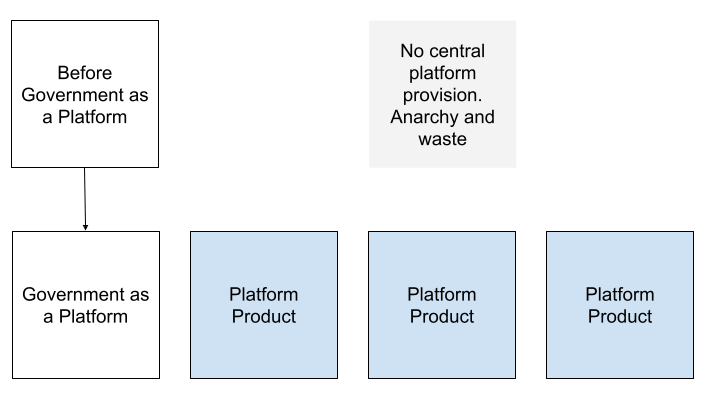
Services adopting these platforms benefit from consistent branding and quality of experience, allowing them to meet user expectations of how interacting with government looks and feels. This improves ease of use, and builds trust. Services benefit from being able to get up and running more quickly, from ease of procurement, cost efficiency, and the accessibility of these products.
At first these platforms were mostly focused on helping teams who already had access to technical capability, as shown by the excellent APIs and developer documentation of these products. But in recent years, these platforms have been expanding into helping teams with less access to technical skills - for example Pay’s payment links feature.
What’s happening now?
GDS’s Digital Service Platforms are operating at scale: each week Pay processes around £30m and Notify sends around 13 million emails, 14 million text messages, and 200,000 letters; the Design System is used on thousands of services. These platforms are the foundation and engine room for a huge range of services across the public sector, from schools and local councils up to massive central government departments.
The procurement, contractual and financial arrangements are designed to make these platforms as easy as possible to adopt. GDS pays centrally for running the platforms, and outside of passing on any per-transaction costs (e.g. the fee for taking a payment, or sending a text message) the offering is free to use. GDS operates a self-service model that keeps operational costs as low as possible, and makes adoption quick and easy for departments. The tremendous growth that we saw during covid was testament to this institutional self-service model, and to the design of the economic approach to the platforms as a whole.
Building centrally and reusing widely is incredibly economically efficient, with a massive return on investment. Notify is projected to save the taxpayer £63 million this financial year, and the Design System £38 million. As we widen the range of services that we can serve, the potential benefits increase further still.
We’re growing adoption of our existing platform products year-on year. And we’re adding to our set of products by building GOV.UK Forms. Currently in private beta, this product addresses a big need that our platform products weren’t previously serving, by allowing services to collect information from users.
Adding Forms also lets us start to change the nature of our platform offering. Up until now, if a government user has wanted to create a service using our components, they’ve had to stitch them together themselves, and think about hosting, technical integration, and end-to-end service design. Because what we offer is a set of tightly-scoped individual components, adopting one of our products doesn’t help you at all in adopting any of our other products, or in making a whole service that combines more than one product.
Forms gives us a chance to change this. Last summer we carried out research that suggested that there’s value in a more joined-up offering that can be used by teams without access to technical capability - but we want to test demand and value in practice. So in Q3 this year we’ve integrated Forms with Notify in a very basic way, and in Q4 we will be integrating Forms with Pay in a very basic way. We’ll use these integrations to test the demand for - and value of - a more joined-up offering. This quiet expansion of our Forms product amounts to an MVP of a platform that empowers teams across government to design, build, operate and iterate simple transactional services without the need for access to developers.
If this work continues to go well, in 24/5 we’ll build on this, progressing towards a platform offering that can either be consumed as individual components parts, or adopted as a whole, without users having to worry about integration, hosting, or any of what’s going on behind the scenes. Ultimately, we want to make it as easy as possible for government to build and run great services for the public, whatever the service team’s size, shape, budget and capabilities.
Helping teams without access to technical skills to transform their service allows us to uncover an extra layer of service transformation across government. This is the next step in the government as a platform vision, going from providing platform components to providing an easy-to-adopt platform that helps build and run the whole service. This helps boost the quality of these services, makes them easier to adapt over time, and saves the taxpayer lots of money.
With even small, simple services often costing hundreds of thousands of pounds (or more) a year to run, helping the thousands of non-transformed services fully digitise has economic potential in the hundreds of millions of pounds, even with a pessimistic estimate of the percentage of services that would be impacted.
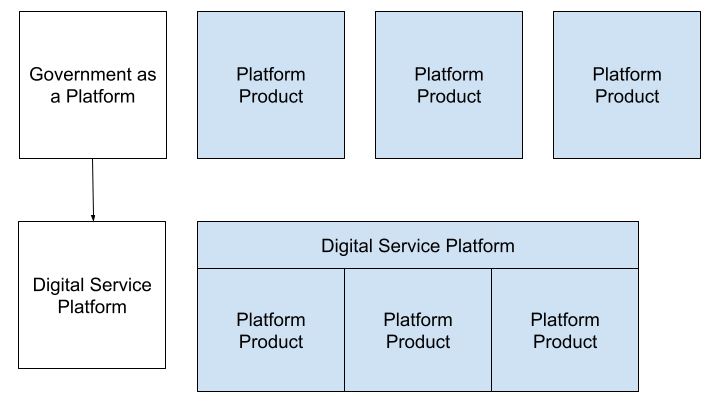
Looking across to the rest of GDS, GOV.UK is soon to start building a native app, with a particular interest in young people, alongside its web estate, and Digital Identity are nearing important adoption milestones with some key departments and services.
Where is GDS going next?
This work across GDS should set the foundations for where we go next, from 2025 to 2030.
The GDS vision is to deliver the public a smoother, more proactive and personalised experience of interacting with government. Working back from this target experience, much of the strategy and work ahead is clear. Data sharing across services, where users consent, to reduce effort and friction, better control of the communication experience, the understanding and anticipation of user circumstances and needs to drive proactive action to help people when they need it, without them having to be experts in government; all underpinned by a smooth, secure and ubiquitous way to prove your identity. This will take a lot of work.
What’s the strategy for delivering this at scale?
To reach this desired future outlined by the emerging GDS strategy, we’ll need to carry out two waves of transformation. One wave is about continuing with the current GDS strategy of digitising the long tail of 9,000 non-transformed document-driven services. The second wave is about building on this and taking digital services to a higher degree of interconnected sophistication.
Hand-crafting all of this transformation would be slow and ruinously expensive, and the ongoing operational costs of a bespoke approach would be prohibitive. Public finances will continue to be under pressure, and government will need and expect rapid deployment of policy into service provision. So the 2025 to 2030 transformation needs to be powered by platforms, to allow it to happen fast, in a cost-effective and high-quality way.
Alongside this, we have an opportunity to be ambitious about our vision for the future of government services. We know that AI will get better over the next 5 years, so we should bake it into the heart of our strategy. This takes us beyond playing catchup to where we should already be, and presents a real vision for transforming services.
The next step for government as a platform is to directly drive service transformation
The next step for government as a platform is to directly help services transform. We’ll do this in two ways: first by going much further to help people make better design decisions for their services, and second, by helping services continually optimise themselves.
We will empower teams to make great design decisions when building digital services
We will use AI, the GDS Design System, and the Government Design Principles.
If our first shift is to go beyond empowering technical specialists to empowering service teams who don’t have access to technical specialists, our second shift is to empower teams who do not have access to service and digital design expertise. This is how we reach the long tail of thousands of government PDF forms.
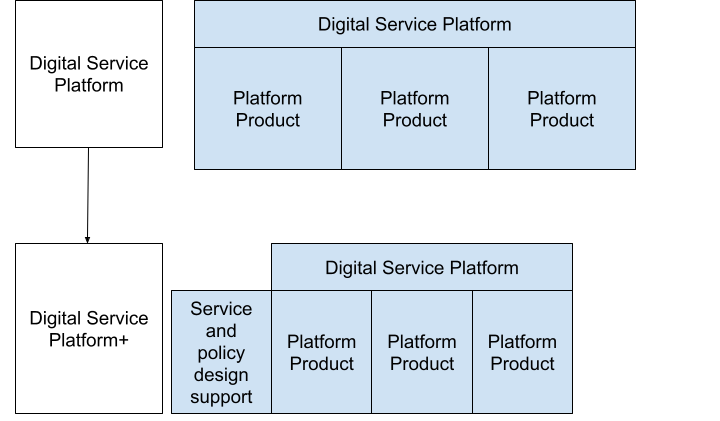
Artificial intelligence capabilities are improving rapidly. AI can already be used to check content against a style guide, check the reading age of a document, or suggest alternatives to jargon. Soon we will be able to harness AI to help people make better decisions when designing and creating services and their associated content, particularly when we power it with an understanding of our Design System and Government Design Principles.
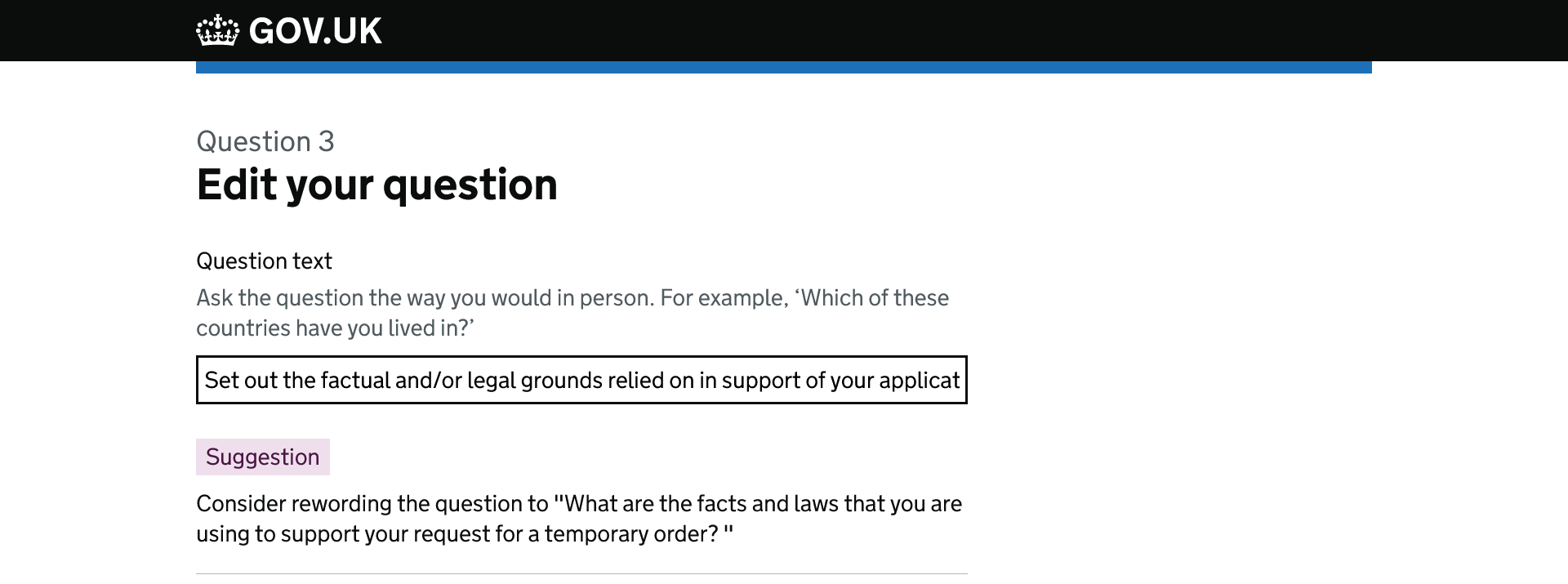 In this prototype, we use a large language model to suggest improvements to make a form question easier to read.
In this prototype, we use a large language model to suggest improvements to make a form question easier to read.
As these capabilities continue to mature, we’ll be able to help government design and build better services from the start - improving policy formation and service design.
Design decisions over the next 5 years are likely to become harder rather than easier. Service interactions may be increasingly mediated through AI agents and through more personalised or multimodal interaction patterns rather than flat HTML pages. For example, a user might access a GOV.UK benefits checker through an AI agent that operates it on their behalf, rather than by visiting GOV.UK themselves. Or a user might be told the steps needed to renew their driving licence by asking an AI agent that has read lots of pages on GOV.UK.
The experience of interacting with government through AI agents may be disintermediated, with private sector actors being increasingly in control of users’ experiences. Their goals and incentives may not match with user needs. Designing for these interactions, and distilling best practice into readily available components, will be a key role for GDS. Similarly, assuming the trust in government continues to become scarcer, we’ll need to design for the retention and reinforcement of trust in government in ways that go beyond the visual recognition of the GOV.UK Design System and GOV.UK Frontend library.
The Design System will broaden out from being a pattern library for components, and move into setting guidance for apps, operational design, policy design, service design and AI interaction surfaces. Cybersecurity threats will increase - over the last year, NCSC have already seen a nearly 64% increase in cyber attacks. So we’ll need to empower people to build services with great cybersecurity, whatever their level of access to technical and cyber expertise. There’s lots of cross-GDS collaborative work to be done to make this happen, with Digital Service Platforms partnering closely with Digital Identity and GOV.UK on this integrated service platform for government.
Taken together, this work sees us move from empowering technical specialists (the first years of the GaaP programme), through to empowering digital and design specialists without access to technical skills (the current work of the Digital Service Platforms programme), and into empowering policy and operational colleagues, so that we can transform all government services. Better policy and better design to make better services for everyone.
But making better design decisions when creating a service is only the start. We need to help government services improve over time.
We will drive ongoing improvement to individual services, and to the wider service platform
Digital government in the UK has never had good insight into how well services are performing. GOV.UK is working on this, through the Single Data Environment, which will start to build a foundation of data on how users interact with services and where they have problems. We’ll bake joined-up analytics into the Digital Service Platform, along with automatically-summarised insights from user feedback, and an understanding of the Government Design Principles. We’ll use these together to give a clear view of how each service is performing, and how it might be improved to deliver better policy outcomes and user experience.
For example, we might pick out a particular step of a service as having an unusually high dropoff rate, and highlight improvements informed by successful examples that we also see on the platform.
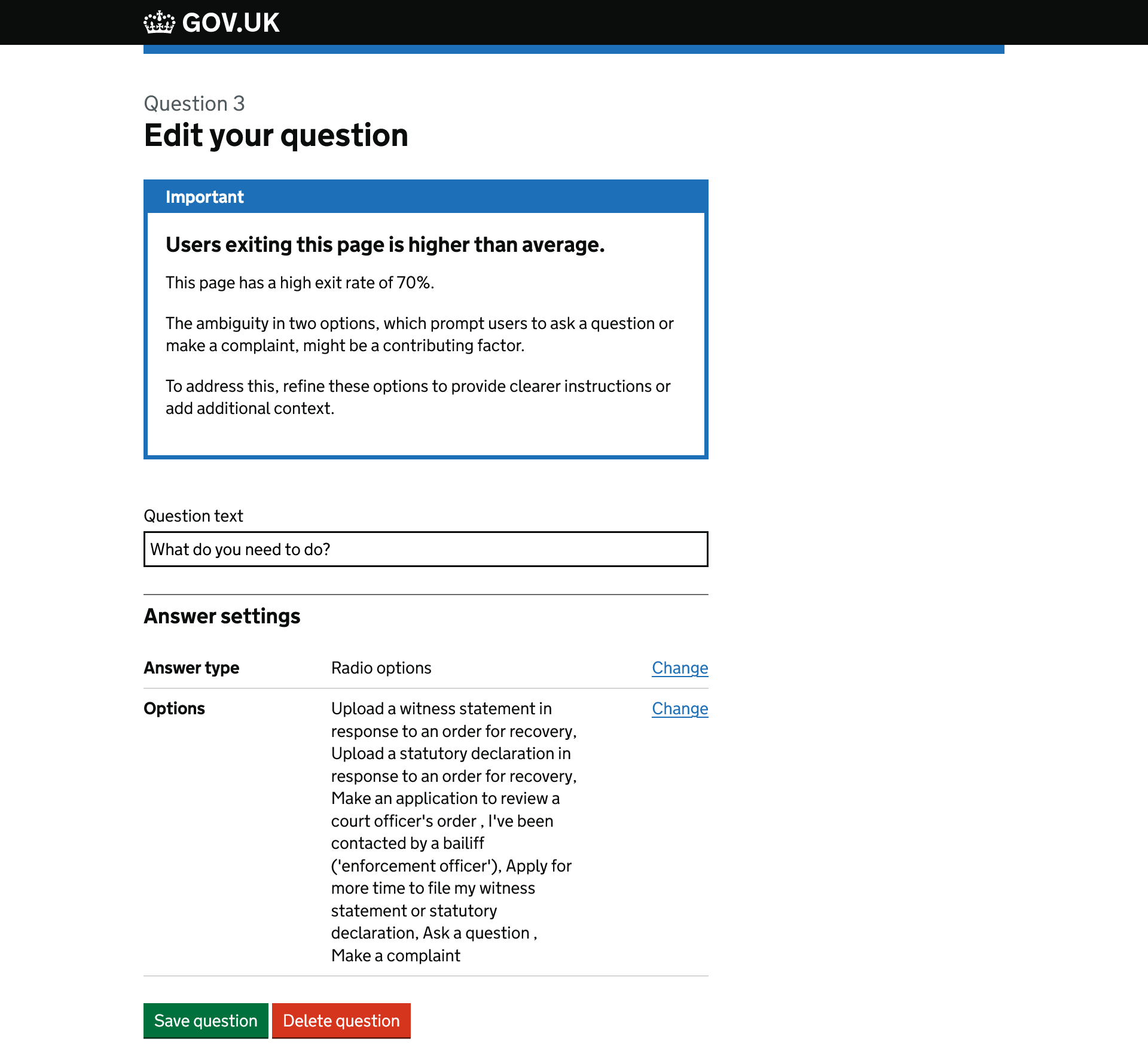
Services will be expected to act on these insights in a swift and timely fashion, and CDDO could be given oversight of these across all services, to make sure that this is happening in practice.
In harnessing data and machine learning, we’ll work carefully to scan for potential unintended consequences, and design deliberately to guard against the dangers of bias and inequity, and to be particularly alert to the needs and experiences of marginalised or vulnerable people.
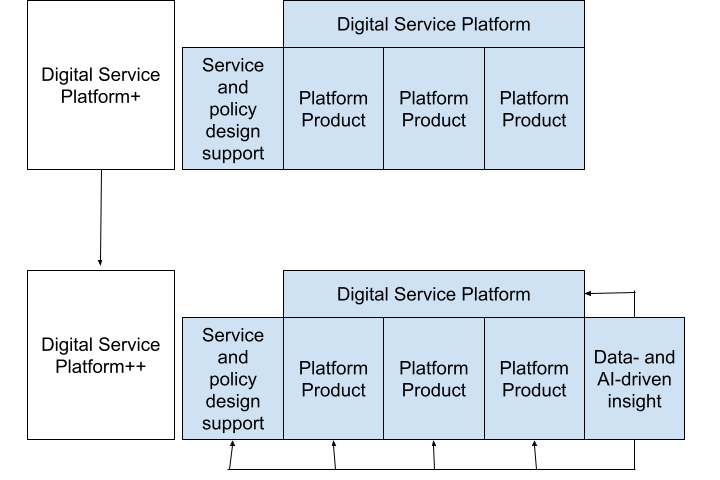
So every service on the joined-up Digital Service Platform will benefit from continuous data- and insight-driven optimisation. We’ll surface this insight to the public and to the people building and running services (from policy through design, delivery and operations), improving scrutiny and decision-making. This will empower government and enable oversight by the public, with high-quality visibility of detailed service performance out-of-the-box.
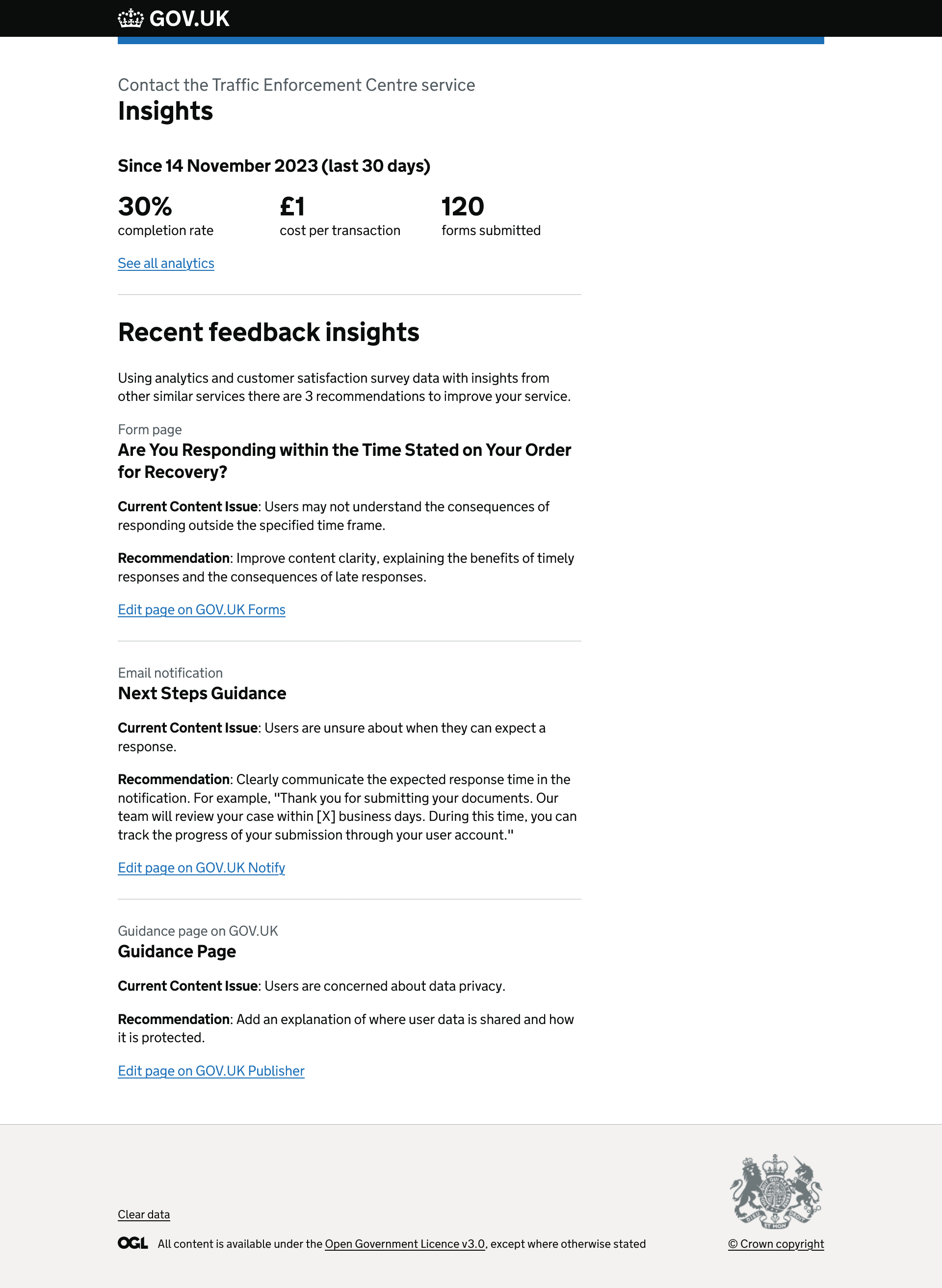 In this prototype, we use performance data and machine learning to give visibility of a whole service. Key areas for improvement are picked out using machine-analysed data and user feedback. Suggestions for improvement span all aspects of the service, including content, form steps, and notifications.
In this prototype, we use performance data and machine learning to give visibility of a whole service. Key areas for improvement are picked out using machine-analysed data and user feedback. Suggestions for improvement span all aspects of the service, including content, form steps, and notifications.
These insights won’t just be used to drive improvements to individual services: they’ll feed back in to components and guidance, so that the platform as a whole - and all the services on it - becomes better at meeting user needs over time.
This is where we harness network effects. At the moment we don’t really make use of the benefits of having so many services using our products. In the next 5 years we’ll change this, and use the scale of government digital delivery to help improve the quality of digital services over time. This use of data and machine learning will directly drive the GDS vision of delivering a smoother, more proactive and personalised experience of interacting with government.
The opportunity ahead
The years 2025 to 2030 offer the prospect of all 9,000 government services being truly digitised, through a government-wide Digital Service Platform. More than this, they offer the prospect of these services being better designed, and improving over time - not just individually, but as an interlocking ecosystem that learns and strengthens together, to keep doing an ever-better job of serving user needs across all government services. This strategy builds on what government as a platform has accomplished up to this date, and uses newly-emerging capabilities, whilst harnessing the breadth, diversity and scale of government. This is GDS’s opportunity to drive the next stage of digital government, and for the UK to regain its international leadership in this space.
Disclaimer: This is early thinking, and not an official GDS blog post. Other possible futures are available - if you have one in mind, I’d love to hear about it. What do you imagine for digital government in 2025-30?